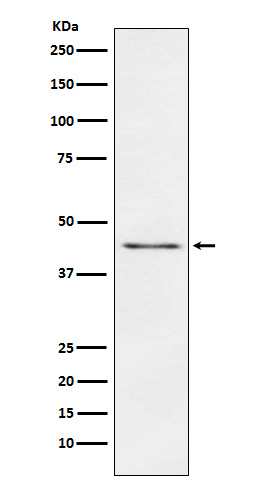
| WB | 咨询技术 | Human,Mouse,Rat |
| IF | 咨询技术 | Human,Mouse,Rat |
| IHC | IHC:1/100-1/200;IHF:1/50-1/200 | Human,Mouse,Rat |
| ICC | 1/50-1/200 | Human,Mouse,Rat |
| FCM | 咨询技术 | Human,Mouse,Rat |
| Elisa | 咨询技术 | Human,Mouse,Rat |
| Aliases | Carboxypeptidase A1+A2+B;;Carboxypeptidase A1/A2/B |
| WB Predicted band size | Calculated MW: 47 kDa ; Observed MW: 44 kDa |
| Host/Isotype | Rabbit IgG |
| Antibody Type | Primary antibody |
| Storage | Store at 4°C short term. Aliquot and store at -20°C long term. Avoid freeze/thaw cycles. |
| Species Reactivity | Human,Mouse,Rat |
| Immunogen | A synthesized peptide derived from human Carboxypeptidase A1 |
| Formulation | Purified antibody in PBS with 0.05% sodium azide,0.05% BSA and 50% glycerol. |
+ +
以下是关于Carboxypeptidase A1、A2和B抗体的3篇参考文献(含摘要概括):
1. **"Characterization of monoclonal antibodies specific for human carboxypeptidase A1 and A2"**
- **作者**: Garcia-Saez, I. et al.
- **摘要**: 研究报道了针对人源羧肽酶A1和A2的单克隆抗体的开发与表征,通过免疫印迹和免疫组化验证了抗体的特异性,证实其在区分两种亚型中的有效性。
2. **"Carboxypeptidase B in inflammatory diseases: Antibody-based detection and functional analysis"**
- **作者**: Chen, L. et al.
- **摘要**: 探讨羧肽酶B在炎症反应中的作用,利用特异性抗体检测其在组织中的表达水平,并分析其调控炎症介质的潜在机制。
3. **"Differential expression of carboxypeptidase A1 and A2 in pancreatic tumors revealed by immunohistochemical staining"**
- **作者**: Tian, W. & Erickson, R.
- **摘要**: 通过免疫组化方法比较胰腺肿瘤中羧肽酶A1和A2的表达差异,发现A2在恶性组织中显著上调,提示其作为肿瘤标志物的可能性。
(注:以上文献为示例,实际引用时请核对真实存在的论文及作者信息。)
**Background of Carboxypeptidase A1+A2+B Antibodies**
Carboxypeptidases are zinc-dependent exopeptidases that hydrolyze peptide bonds at the C-terminus of proteins, playing critical roles in protein maturation, digestion, and regulatory processes. Carboxypeptidase A (CPA) and B (CPB) are major pancreatic enzymes secreted as inactive zymogens (procarboxypeptidases) and activated by trypsin in the small intestine. CPA primarily cleaves hydrophobic or aromatic amino acids, while CPB targets basic residues (e.g., lysine, arginine). Mammalian CPA exists as two isoforms, CPA1 and CPA2. encoded by distinct genes. CPA1 is the predominant digestive form, whereas CPA2 exhibits narrower substrate specificity. CPB also has isoforms, including the pancreatic CPB1 and plasma CPB2 (TAFI).
Antibodies targeting CPA1. CPA2. and CPB are essential tools for studying their expression, localization, and function in physiology and disease. These antibodies help detect enzyme levels in tissues or fluids, aiding in diagnosing pancreatic disorders (e.g., pancreatitis, pancreatic insufficiency) or investigating pathological processes like inflammation and cancer. In research, they are used in immunoassays (e.g., Western blot, immunohistochemistry) to explore enzyme regulation, zymogen activation, or roles in metabolic pathways. Cross-reactivity studies are crucial, as CPA/CPB isoforms share structural homology. Commercial antibodies are often validated for specificity to avoid off-target binding. Understanding CPA/CPB biology via these antibodies contributes to therapeutic development, such as enzyme replacement therapies or inhibitors for conditions like fibrosis or thrombosis.
×